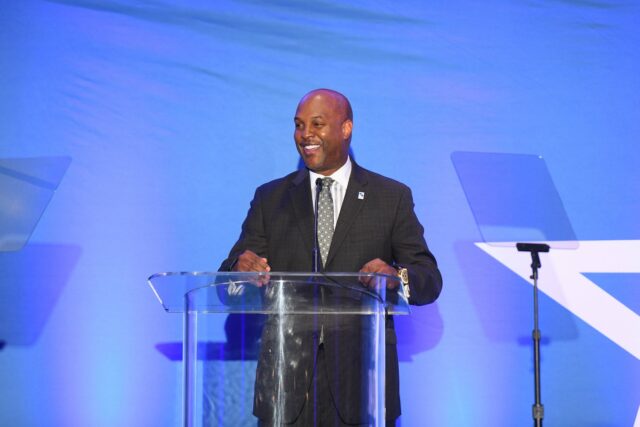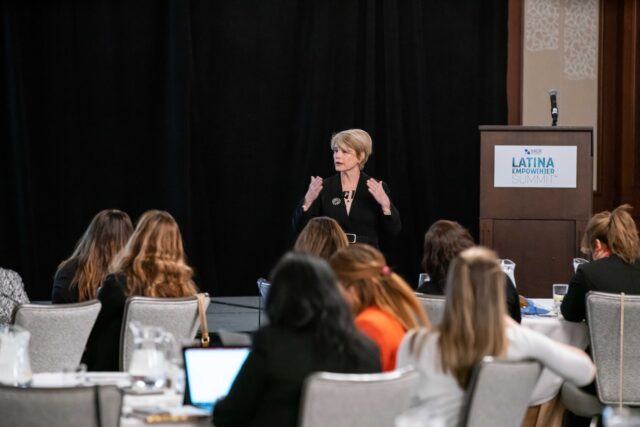In the mid-1980s, a group of prominent Hispanic and Latino leaders realized that there was a widening gap between the companies marketing to their community and the opportunities available to people of color at those companies. In order to hold those organizations accountable, the Hispanic Association on Corporate Responsibility (HACR) was created. In the 35 years since its inception, HACR has engaged with cross-industry partners to advance Hispanic and Latino representation throughout corporate America, including the C-suite and boardrooms.
Dell Perspectives spoke with Cid Wilson, president and CEO of HACR, about the importance of diverse boards, the effect that inclusion has on company culture and the need for the tech industry to increase its procurement, employment and governance efforts to include leaders of color.
Tell us a bit about yourself and your background. How did you find your way to HACR?
I was named the president and CEO of HACR in 2014 after 21 years of experience on Wall Street working in equity research. I’ve been involved with HACR in some capacity for the last 15 years or so, attending events as a participant and then engaging with many of the major national Hispanic organizations that make up our board of directors. Although when I came into this role I was new to being a CEO, I was not new to the space that we’re in with regards to Hispanic inclusion, and I was not new to Latino leadership circles.

Going back to my days on Wall Street, one of the major challenges is that there’s not a lot of ethnic diversity in those spaces, and I certainly was one of the few not just Latino or Black people, but the only person of any color in those environments. I made it my moral case that if I was going to be in those roles, I wanted to make sure that I was connecting as many Latinos as I could, and also be an advocate for a more inclusive environment.
What qualifies a boardroom as “diverse” in the eyes of HACR?
Let me start by saying that we really want companies to maximize their inclusion capabilities, so it’s not enough to have one Latino person on your board, right? Our goal is to make the moral, business and valuation case of why having more Hispanic and Latino people in board seats is not only the right thing to do, it’s smart business and it’s going to increase shareholder value.
We worked with our Alliance for Board Diversity partners (including Catalyst, the Executive Leadership Council and Leadership Education for Asian Pacifics), as well as Deloitte on our Missing Pieces report, and it found that among Fortune 500 companies, only 4.1% had Hispanic or Latino members sitting in board seats. We want to move the needle on getting these companies to change their corporate culture so that they not only have more Latinos on their boards but more diversity period.
Our goal is to make the moral, business and valuation case of why having more Hispanic and Latino people in board seats is not only the right thing to do, it’s smart business and it’s going to increase shareholder value.
—Cid Wilson, president and CEO of HACR
How does board diversity contribute to overall company culture?
The guardians of corporate culture are the board of directors. They decide how inclusive the company is going to be, and their job is to evaluate the effectiveness of the CEO in creating a culturally inclusive company. One of the reasons that we place such an emphasis on board diversity is because we know that there’s a correlation between a diverse board and a diverse culture as executed by the CEO.
The makeup of the boardroom promotes a more inclusive C-suite, more inclusive pipeline development of people of color in mid- to high-level positions, and it promotes a more inclusive recruiting strategy. If you’re a non-diverse board member asking your non-diverse colleague who they know that could be good on the board, they are more likely to recommend candidates that are not diverse. Now, at HACR, by pushing for the addition of Latinos or people of color at that table, we can encourage what I call “intentional inclusion,” which promotes the intentionality of saying, “Because I have the lived experience and point of view of being Hispanic or Latino, we, as a board, can effectively look someone who also has these racial and cultural experiences.”

How did HACR determine that there was a need to push for more inclusion of this community in particular? What are some of the barriers or challenges that employees face in corporate spaces?
When HACR was founded in 1986, many Hispanic organizations realized that America was not prioritizing Hispanic inclusion as it should have been. And for the last 35 years, we have been recognizing that there is an opportunity to move the needle when it comes to representation at the higher levels of not just Fortune 500 companies but small- to mid-size public and private companies where those numbers were just not high enough.
There is no question that we’ve seen progress in the numbers of Hispanic employees in entry-level up to mid-level manager positions. At these levels, hiring is a lot about a candidate’s qualifications and work experience. However, when you make the leap from mid-level manager to senior and executive corporate positions, that’s what you see a significant drop-off that tells us that there’s more work to be done to move people of color into these senior-level roles. For these positions, it becomes more about sponsorship: Who does a candidate know who can vouch for them?
By the time we get to the C-suite, the hiring criteria are probably 90% sponsorship and 10% work experience. Somebody felt that they could put their own credibility on the line to support the promotion or hiring of this individual, and credibility is a function of who views you as credible. And the challenge is that if you’re not in a corporate culture or an environment where you can see the great credibility that we have within our Latino board candidates, you’re never going to see those hirings take place.
“For the last 35 years, [HACR has been] recognizing that there is an opportunity to move the needle when it comes to representation at the higher levels of not just Fortune 500 companies but small- to mid-size public and private companies where those numbers were just not high enough.”
—Cid Wilson, president and CEO of HACR
HACR boasts a number of large corporations as member partners—including giants in the financial, pharmaceutical, telecom, and oil and gas industries. How does HACR vet its partners?
We view these partners as being in a relationship with us. And by relationship, I mean a commitment to advancing Hispanic inclusion at your company, to holding yourself accountable and to fostering a pipeline that can increase the number of Latinos rising up in your organization. We’re looking for companies that are interested in creating corporate accountability structures that will change the way they operate for the better.
How can tech companies, specifically, make a larger commitment to diversity in the boardroom?
Tech companies must double down on diversity. At the moment, the numbers are really lagging. To fix that, the industry as a whole has to invest in not only a diverse recruiting strategy, but also an overarching cultural diversity and pipeline development strategy. We have to make sure that employees are being given the opportunity to develop the skill sets that they need in order to evolve into management roles.
I believe the tech industry has a multi-pronged challenge in this regard. On the one hand, they are not hiring enough [people of color] for tech-specific positions. The other problem is that for the people who are hired into finance, marketing, HR positions—roles that are not always within the STEM purview—we need to ensure that they can move into managerial roles with a concrete understanding of the tech component of what their company does, because that sometimes becomes an obstacle of pipeline development the higher you get in a company.

How do corporate agreements of the kind that HACR and its members create get brought to life? What are the first steps that companies can make to increase representation?
The way we would engage a company that’s very early in its diversity journey might be very different from how we engage a company that’s very advanced in that respect. The first step is to be transparent with us on where your company is when it comes to inclusion and representation. Depending on where a company lands on our Corporate Inclusion Index, there are different tactics that we might take. Ultimately, it comes down to speaking with the CEO, chief diversity or HR officers, the leaders at all parts of the corporate ecosystem to create a culture of belonging that is bounced around that kind of echo chamber until it becomes part of an organization’s DNA.
While we want to hold these partners accountable for increasing the representation of employees of color, we also want to celebrate with them as they move the needle on improving their numbers, and as they retain, support and nurture these employees. Our goal has always been to [be] a strong partner to our corporate member companies so that they see the value in engaging with us, and we do that by emphasizing the relationship we build.
Lead photo of Cid Wilson courtesy of HACR